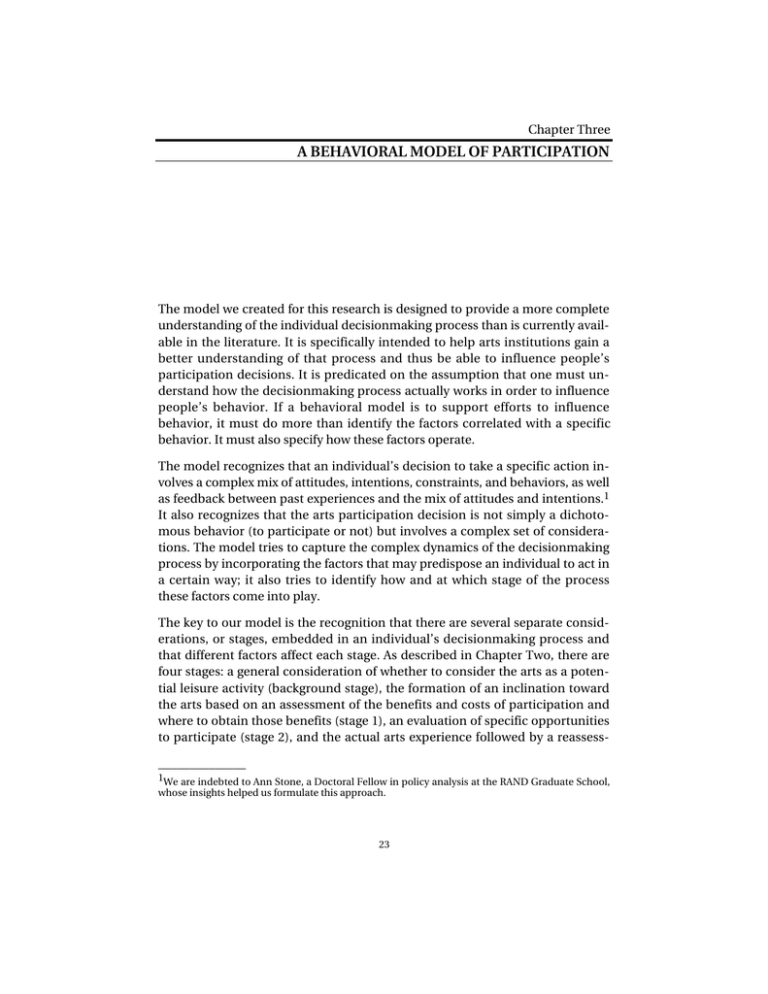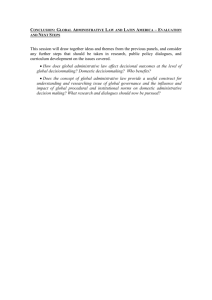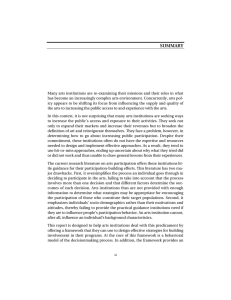A BEHAVIORAL MODEL OF PARTICIPATION
advertisement

Chapter Three A BEHAVIORAL MODEL OF PARTICIPATION The model we created for this research is designed to provide a more complete understanding of the individual decisionmaking process than is currently available in the literature. It is specifically intended to help arts institutions gain a better understanding of that process and thus be able to influence people’s participation decisions. It is predicated on the assumption that one must understand how the decisionmaking process actually works in order to influence people’s behavior. If a behavioral model is to support efforts to influence behavior, it must do more than identify the factors correlated with a specific behavior. It must also specify how these factors operate. The model recognizes that an individual’s decision to take a specific action involves a complex mix of attitudes, intentions, constraints, and behaviors, as well as feedback between past experiences and the mix of attitudes and intentions.1 It also recognizes that the arts participation decision is not simply a dichotomous behavior (to participate or not) but involves a complex set of considerations. The model tries to capture the complex dynamics of the decisionmaking process by incorporating the factors that may predispose an individual to act in a certain way; it also tries to identify how and at which stage of the process these factors come into play. The key to our model is the recognition that there are several separate considerations, or stages, embedded in an individual’s decisionmaking process and that different factors affect each stage. As described in Chapter Two, there are four stages: a general consideration of whether to consider the arts as a potential leisure activity (background stage), the formation of an inclination toward the arts based on an assessment of the benefits and costs of participation and where to obtain those benefits (stage 1), an evaluation of specific opportunities to participate (stage 2), and the actual arts experience followed by a reassess______________ 1We are indebted to Ann Stone, a Doctoral Fellow in policy analysis at the RAND Graduate School, whose insights helped us formulate this approach. 23 24 A New Framework for Building Participation in the Arts ment of the benefits and costs of the arts (stage 3). These stages link background factors to attitudes, attitudes to intentions, intentions to actual behavior, and past behavior to future behavior. In addition, the model assumes that the effects of a particular set of factors on the decisionmaking process as a whole will be moderated by where those effects are most relevant to decisionmaking. As noted above, for example, to understand the effects of ticket prices on participation, it is important to focus not on all potential participants but on those already inclined to participate and thus likely to be at the stage in the decisionmaking process at which they care about the price of tickets. This point also helps to explain why it may be particularly important for an individual’s initial experiences with the arts to be positive, since that experience can play a critical role in determining whether the individual is a repeat participant. Figure 3.1 is a schematic of our participation model—i.e., the different stages an individual goes through in making participation decisions. As noted in Chapter Two, this is not to say that all individuals move self-consciously through the same process in deciding whether to participate in an arts program; instead, the model is meant to suggest important differences among people that can best be understood by recognizing that there are different components in the decisionmaking process. This distinction also helps make it clear that positive perceptions of the arts tend to precede any practical considerations about whether to attend a certain program or perform in an artistic event. RANDMR1323-3.1 Background • Sociodemographic factors Perceptual • Socio-cultural factors Experience Personal beliefs about arts participation • Personality factors • Past experience Practical Perceptions of social norms toward arts participation Attitudes toward arts participation Intention/ decision to participate Figure 3.1—Participation Model Participation Reaction to experience A Behavioral Model of Participation 25 BACKGROUND STAGE As Figure 3.1 shows, the model starts with an assessment of the set of background factors that shape an individual’s general attitudes toward the arts. These factors, which reflect characteristics given prominence in the theoretical literature on participation, can be sorted into four categories: • Socio-demographic factors—those describing an individual’s social (education, income, occupation, etc.) and demographic (age, gender, life-cycle stage) characteristics. • Personality factors—those that are unique to the individual. • An individual’s prior experiences with the arts. • Socio-cultural factors—those describing an individual’s group affiliations and identities. At least initially, these background factors are exogenous to the participation decision because they are already established. Subsequent experience with the arts, however, can modify at least some of them, such as group identification or affiliation and prior experiences. Indeed, stage 3 of the model suggests that individuals will re-evaluate their attitudes toward arts participation based on their actual experiences. PERCEPTUAL STAGE Before considering whether to participate in a specific way, individuals are likely to assess the benefits and costs of arts participation and the different types of art and forms of participation they might choose. In other words, they must develop a predisposition, or inclination, to participate. These considerations will be influenced both by their attitudes toward the arts, including their perceptions of the benefits and costs of arts participation, and by their understanding of the social norms of their reference groups (relatives and friends) with respect to arts participation. The model recognizes that individuals’ attitudes toward the arts are shaped both by their own beliefs and by the attitudes of the social groups with which they identify. It is possible, for example, that individuals personally predisposed toward the arts may not act on that predisposition because their reference groups would not consider it acceptable behavior. It could also happen that they participate not because they themselves are inclined to do so but because a friend or family member has brought them along. The relative importance of these two components in shaping an individual’s overall inclination toward the arts will vary across individuals and groups and may well change over time. 26 A New Framework for Building Participation in the Arts The key point here is that an individual’s attitudes toward the arts can predispose him or her either toward or against participation. An individual who is disinclined to participate will have a perceptual barrier that may be very difficult to overcome, regardless of what practical steps are taken to facilitate participation. Moreover, because these inclinations are based on individuals’ personal beliefs about the benefits to be derived from the arts and their perceptions of how their reference groups perceive the arts, changing these inclinations can be very difficult and time consuming. In fact, changing an individual’s inclinations may sometimes require changing the attitudes of his or her social groups. An individual’s inclination to participate will vary along a continuum from very strongly inclined to very strongly disinclined. The difficulty of getting someone to consider participating will vary according to the strength of his or her inclination and the form of participation. It will be easier to get arts aficionados, who are strongly inclined to participate, to consider participation than it will be to do so for casual attenders, who are much less inclined. In addition, because some forms of participation require very little effort (watching an arts program on television, listening to music on the radio), even those individuals who are only mildly inclined may be willing to give participation a try. Other forms of participation that involve considerably more effort (such as attending a concert, which might involve getting dressed up, traveling some distance, and being present for two to three hours), however, will require a greater inclination on the part of the individual. Similarly, the efficacy of efforts to change individuals’ inclinations by influencing their personal beliefs about the arts or those of their reference groups will vary depending on the strength of the individuals’ inclinations and the degree of influence the reference groups wield over their behavior. In this context, it is important to recognize, as we suggested in Figure 2.1, that individuals may participate in the arts not just for the personal benefits they receive but also for the social experience. This social dimension can also affect the way in which individuals participate. For example, individuals who value the social aspects of arts participation may well be more inclined to attend concerts than those who do not value them. Finally, how broadly one defines the arts affects the tally of people considered to be predisposed toward participation. For example, if popular music is included in the definition, then many more individuals will fall into the inclined category. Similarly, individual inclinations will vary across different types of art. A Behavioral Model of Participation 27 PRACTICAL STAGE Individuals who have decided to become involved in the arts in some way have moved into the practical stage of the decisionmaking process and are ready to evaluate specific participation options. Even for these people, however, there are practical obstacles—lack of information about specific programs, high cost, lack of time, inconvenience, etc.—that must be addressed before they will actually participate at a specific time and place. Furthermore, the difficulty of overcoming these obstacles will depend on the strength of the person’s inclination. People strongly inclined to participate are much less likely to be deterred by practical obstacles than are people only marginally inclined to participate. In fact, the strongly inclined are very likely to seek out extensive information on what is available, at what costs, and when. Those less strongly inclined, who will be more unfamiliar with the arts and thus more likely not to follow them on a regular basis, will not be as likely to seek out information, relying instead on word of mouth (referrals from friends and relatives) and the “buzz” surrounding specific events. EXPERIENCE STAGE If the practical barriers can be overcome, an individual will participate in a specific arts event and subsequently evaluate that experience. The arts experience can take several forms. Some individuals, for example, may choose to attend a performance or visit a museum. Others may decide to create art by studying to become an artist or working in some capacity in production (e.g., as a stagehand or selling tickets). The range of options will vary depending on the individual’s familiarity with the arts and whether he or she has become part of an arts community, as suggested in Chapter Two. For those involved in a specific institution, the range is very likely to include serving as a volunteer, taking part in programming and outreach efforts, and contributing financially. These different modes of participation are not mutually exclusive; as the literature suggests, the more strongly predisposed individuals are toward the arts, the more likely they are to participate in multiple ways. An individual’s reaction to the experience will be influenced by a number of factors, including knowledge of the particular type of art, the value he or she gives to the social aspect of the experience, and the degree to which he or she derives personal fulfillment through the arts. Research has established that the better people understand an activity, the more likely they are to enjoy it (Kelley and Freisinger, 2000). Just as someone’s enjoyment of a non-art form of leisure activity (say, a sport) increases with his or her understanding of that activity, so too does an individual’s enjoyment of the arts increase as he or she knows more about them. As individuals become more familiar with and thus more knowl- 28 A New Framework for Building Participation in the Arts edgeable about a particular type of art, their tastes are very likely to grow more varied and they will appreciate a wider range of programming. Arts experiences can also have a social component. Many people are first introduced to the arts by their friends or family—often at an early age. Some individuals give high value to the social contacts afforded by the arts experience, and some find personal fulfillment and a sense of identity by connecting with a wider community of arts lovers (say, those who support a particular arts institution). The opportunities that arts experiences provide for creativity, fulfillment, and personal meaning can also be a means of personal transformation for participants. This dimension of the experience, although difficult to measure, is an important factor in motivating individuals to deepen their participation, according to a recent study (Heinz Endowments, 1999) that identifies psychological themes people associate with the arts, such as the arts as “transporter” or “redeemer.” After individuals participate in an arts activity, their reaction to the experience then influences their subsequent decisions about whether to participate (as shown in Figure 3.1 by the arrows leading back to beliefs and perceptions). A particular arts experience can change individuals’ expectations (for better or worse) about what the arts have to offer. It may also affect their receptivity (increasing or decreasing it) to their existing reference groups. It even can lead individuals to change their reference groups—for example, by increasing their identification with individuals who are more involved in the arts. As noted in Chapter Two, the most committed participants are likely to become immersed in a community of aficionados who view the arts (and perhaps a specific arts institution) as an essential component of their identity. Whether the outcome is positive or negative, the arts experience will feed back into the individual’s overall experience, altering his or her attitudes and values and influencing future participation decisions. Frequent positive experiences can stimulate a person to participate more often and in more ways. Frequent participants are also more likely to participate in multiple art forms (Peters and Cherbo, 1996). ADVANTAGES OF MODEL Although our model is more elaborate than the standard theoretical approach, we recognize that it still cannot capture the full complexity of the decisionmaking process. Its value lies in its ability to reduce that complexity so as to arrive at a clearer understanding of the distinctions among types of influences on the decision and the effect of certain sets of factors on others. As long as the model avoids serious distortions of the decisionmaking process, it can serve a number of useful purposes. A Behavioral Model of Participation 29 The advantage of the model’s way of describing participation is that it can help organizations develop more targeted—and therefore more effective—initiatives for encouraging participation. By recognizing that individuals can be grouped according to their stage within the participation decisionmaking process—and that different types of obstacles to participation are associated with each stage—the model can help institutions identify the tactics that will address the obstacles most relevant to their target group. Each stage of the decisionmaking process provides guidance for developing effective institutional strategies.





